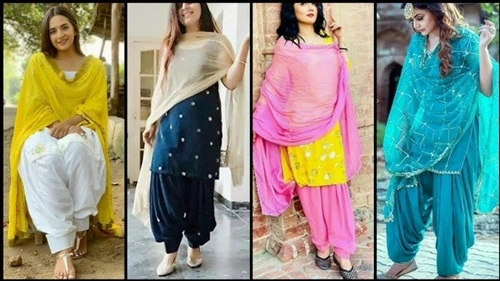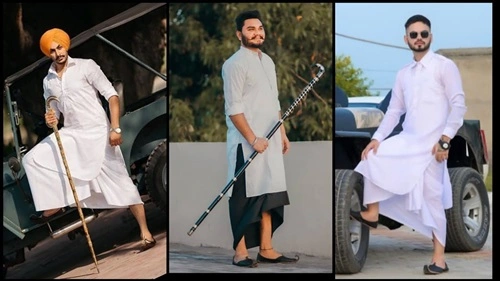We all know by this point how deep of a history Punjab has been through and what contributions the Sikh community has made for the betterment of the nation for a long time. And that’s pretty much the reason why Punjab people believe in preserving their culture, no matter what. Once you’re in Punjab, it is actually a totally different vibe, which is chill, fun and very colourful, to be honest. One thing that’ll stand out to you the most is the way the native people dress, like, you’ll see a lot of people still wearing traditional dresses, and not just for the sake of it. Nah! They enjoy it and take pride in it too. So, let’s see what are the traditional dresses of Punjab.
Traditional Dresses for Women of Punjab
1. Salwar Kameez & Patiala Suit

This is basically the most popular traditional attire of Punjabi women, like, salwar, a loose, pleated pant, kurti, a short top; and dupatta, a long scarf. Patiala Salwar is baggier with many folds in it, which kinda ultimately is super comfortable. It feels awesome and that’s why all women wear it while attending a wedding or celebration.
2. Phulkari Embroidery
Phulkari means flowers work, and this is a really old, pretty cool embroidery form from Punjab. These are done with super-bright threads on shawls, kurtis, dupattas, and lehengas. Punjabi women like to wear it at festivals and weddings: it shows their culture, and it definitely looks utterly awesome.
3. Punjabi Ghaghra
It was used by women in Punjab long ago, before the salwar kameez became very fashionable. It is essentially a long flowing skirt and an equally long flowy top. Nowadays, women prefer wearing it generally for Gidha, an awesome traditional dance. The ghagra twirls super fine when you dance in it.
4. Pothohari Suit
The outfit belongs to the Pothohar region and is basically unlike anything else. It is a very wide salwar with a very loose kameez top and a big headscarf. It is the very much traditional outfit, and some women still wear it in some specific rural spots.
5. Bridal Attire
Punjabi brides kinda give off that royal vibe on their special day when the heavy lehenga choli or salwar kameez is adorned in bright red or maroon colours. The abolishments have the shine of embroidery, mirror-work, and bead-work. Also, the brides wear kaleeras, which are bangles that hang in wishes of love and blessings.
6. Gidha Chudidar
Gidha is a fun dance performance done by women, for which the ladies wear colourful salwar kameez, lehenga-kurti outfits complemented with bright dupattas. The outfits are very vibrant and lively, almost like the dance form itself.
Traditional Dresses for Men of Punjab
1. Kurta-Pyjama and Kurta-Chadra

The most standard Punjabi outfit for men is kurta pyjama or a kurta with a chadra. Kurta is a long shirt, while pyjamas are loose, baggy trousers. Some people also wear a kurta with chadra, which is exactly similar, but instead of using the pants, one wraps a long piece of cloth around the waist.
2. Pathani Suit
This suit consists of a long, straight kurta with churidar or salwar with a drape. Very simple yet super stylish. Mostly Punjabi men wear it during big celebrations.
3. Tamba/Tehmat
It is something like a folded lungi along with the kurta. It is highly difficult to find this in anything else, unless it’s for the performance of Bhangra dance. The style seems to be very lively, and the costume appears to provide the dancer a complete individualistic touch.
4. Jama
All the Punjab boys put on Jama in the olden days of Mughal rule. This tight-fitted top and an extremely flared lower part, much like the gown, is what it is. Then of course, it was worn with a turban and looked very royal. Well, not many people wear it these days, but yes, it does have that special feeling for Punjabi tradition.
5. Sikh Chola
The Sikh Chola was once the flowing garment worn by the Sikh warriors. It allowed their easy movements through battles. A few of the old ones are preserved in cool places like museums. It is related to the bravery and tradition of this society.
6. Turban (Pagdi)
In fact, a turban is much more than just something you wear on your head. For Sikh men, it is quite a big deal indeed, and it very much is the symbol of honour and identity, pride in itself. The binding, the colour and style give away a lot about someone, you know, all that stuff like where they are from or what their profession is.